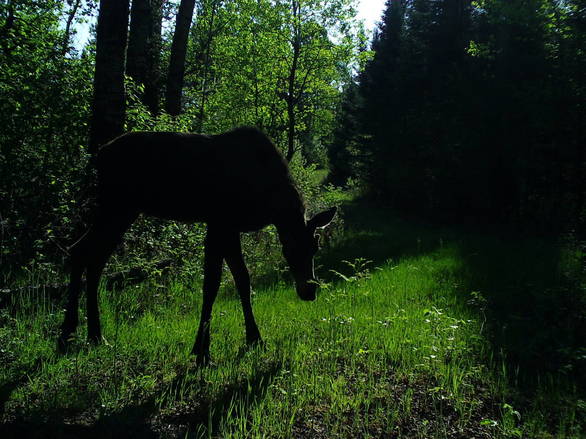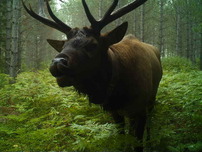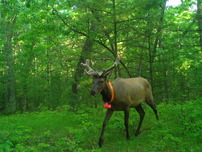|
There was a lot of excitement last month among the Snapshot Wisconsin Research Team when we received an email from one of our volunteers, Jo Ann in Oneida County, reporting a moose photo on her Snapshot Wisconsin camera! This was the first confirmation of a moose captured on one of our project cameras and also the first rare species we have confirmed on one of our cameras. Subsequently, we checked the database of MySnapshot classifications and found a second moose photo from about the same time period (May 2018) but this moose was in Vilas County.
We are also excited to be able to share this Rare Species report back with our community of volunteers and supporters because it happened pretty recently. Often with our project in particular and science reporting in general, it can take several months to be able to report out results. In this case, due to the efforts of our volunteers we were able to report this out almost as soon as it happened! Whether you are a Zooniverse volunteer or a trail camera host, if you see a rare species in a Snapshot Wisconsin photo please let us know! With over 21 million photos and growing we are bound to find martens, cougar, whooping cranes or other rare species eventually.
Photos below - first is Oneida County then Vilas, apologies for the poor image quality - our cameras are not set up to capture images of such large critters!


 |
|
Volunteer of the Month
is a new addition to e-newsletter with the goal of highlighting volunteers that
go above and beyond with their participation in Snapshot Wisconsin. We will also be sharing this series on our blog and the Wisconsin DNR Facebook page.
August’s Volunteer of the Month goes to Skylar from
Marquette County! Skylar has been with Snapshot Wisconsin for over two years,
one of his motivations for joining the project was to bridge his interests in
nature and technology. As a teacher, he utilizes his Snapshot Wisconsin camera
to help connect students with the diverse wildlife residing in their school
forest. When asked about his fondest memories with the project, Skylar
responded:
“It was really
amazing to see how our photos of a fisher, or fishers, at the school forest
contribute to the southward expansion of that species’ known range in our
state. That was something that was really exciting to share with the students
especially because it showed them clearly why their work on this project
matters and how they are contributing to science that has an impact.”
Thank you, Skylar and the awesome students at
High Marq! Thank you to all our trail camera hosts and Zooniverse volunteers
for helping us discover our wildlife together.
|
Did you see the news? This article by Paul Smith in the Milwaukee Journal Sentinel on July 8 shared our plans for the launch of "Phase 2 of Snapshot Wisconsin." Stay tuned for another newsletter from us later this week with all the plans for the next 4 years of Snapshot Wisconsin. We will be opening all the counties and beginning to approve applications for cameras on public land. The Snapshot Wisconsin research team will be doing Facebook Live on Thursday, August 9th at 4pm to talk about the statewide launch! |
|
 |
 |
|
If you need a break from the busy-ness of summer or are lounging on the couch in the air conditioning we would appreciate your participation on our Zooniverse site. Summer is always a slower time for our online volunteers, which is understandable, we want to be outside too! However, we have over a million photos coming in every month so the need for classifications never ends! Please visit our Zooniverse site and classify a few cute deer, otters or bears today! |
 |
|
Ask the Researcher is a recurring feature in our newsletter. If you have a question for a DNR Research Scientist or a member of the Snapshot Wisconsin Research Team please email it to DNRSnapshotWisconsin@Wisconsin.gov with the subject line: Ask the Researcher. Please limit your questions to those related to DNR Applied Science Research, Snapshot Wisconsin or ecological research with trail cameras.
Question from Lori: Wondering what the movement of elk has shown, do they
tend to stay in the same area for a period of time, do they move on to new
areas quite often, or do they have a cycle of moving through and then returning
again?
Answer from Joe Dittrich, Assistant Deer and Elk Research Scientist: Great question Lori! Elk in the western states often have
distinct summer and winter ranges. These animals typically spend summers at
higher elevations, in areas including alpine meadows, and winter at lower
elevations where there is less snow cover. In Wisconsin we don’t have mountains
but our elk do use different habitats and aspects (hill slope direction) throughout
the year. For example, forest openings and areas with good herbaceous cover are
important feeding areas during the spring and summer while conifer forests are
more heavily used, as thermal cover, in the winter. Also, elk spend more time
on south-facing slopes in the winter and spring because these slopes receive
more sunshine and are usually warmer and have less snow than other aspects.
Regarding movement patterns of individual
elk, I can tell you that movements are influenced by variables including time of
year, sex, and age and there is quite a bit of variation between animals. Some elk
spend most of their time in a relatively small area while others are more rangy
– we’ve had individuals move approximately 20 miles in one day. We expect the Kentucky
elk that were recently released in Black River Falls and the Flambeau River
State Forest to take a while to settle into a regular routine because the
landscape is new and unfamiliar to them. We should have a much better idea of
home range sizes and habitat use in the next year or two after the elk
acclimate to their surroundings.
|
We will share one awesome animal photo each month. To enter one of your favorites from a Snapshot Wisconsin camera please send the image as a jpeg attachment with the animal classification, county location and date taken along with the reason why you love the image to DNRSnapshotWisconsin@wisconsin.gov.
This month's image was submitted by Ed in Richland County. This photo taken June 23,
2018, Ed nominated this great picture because it captures twin fawns in
the same pose with their mother.
Other interesting photos from our cameras can be viewed and classified on our Zooniverse site!

Contact Information for Snapshot Wisconsin
Phone: 608-572-6103
Participate on Zooniverse: www.SnapshotWisconsin.org
Find out more details on our webpage:
dnr.wi.gov Keyword "Snapshot Wisconsin

|